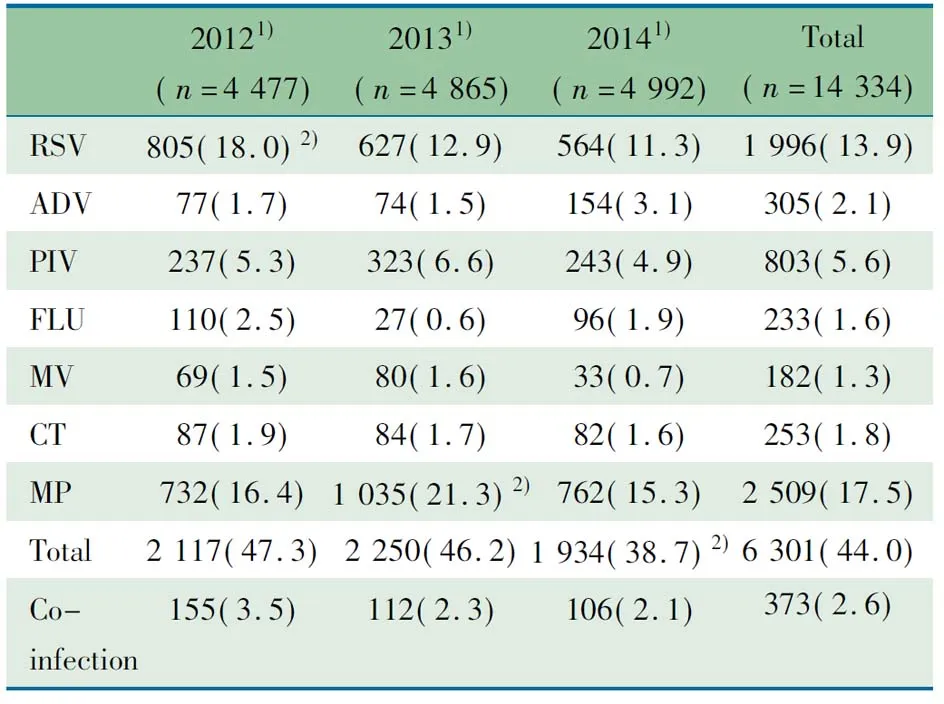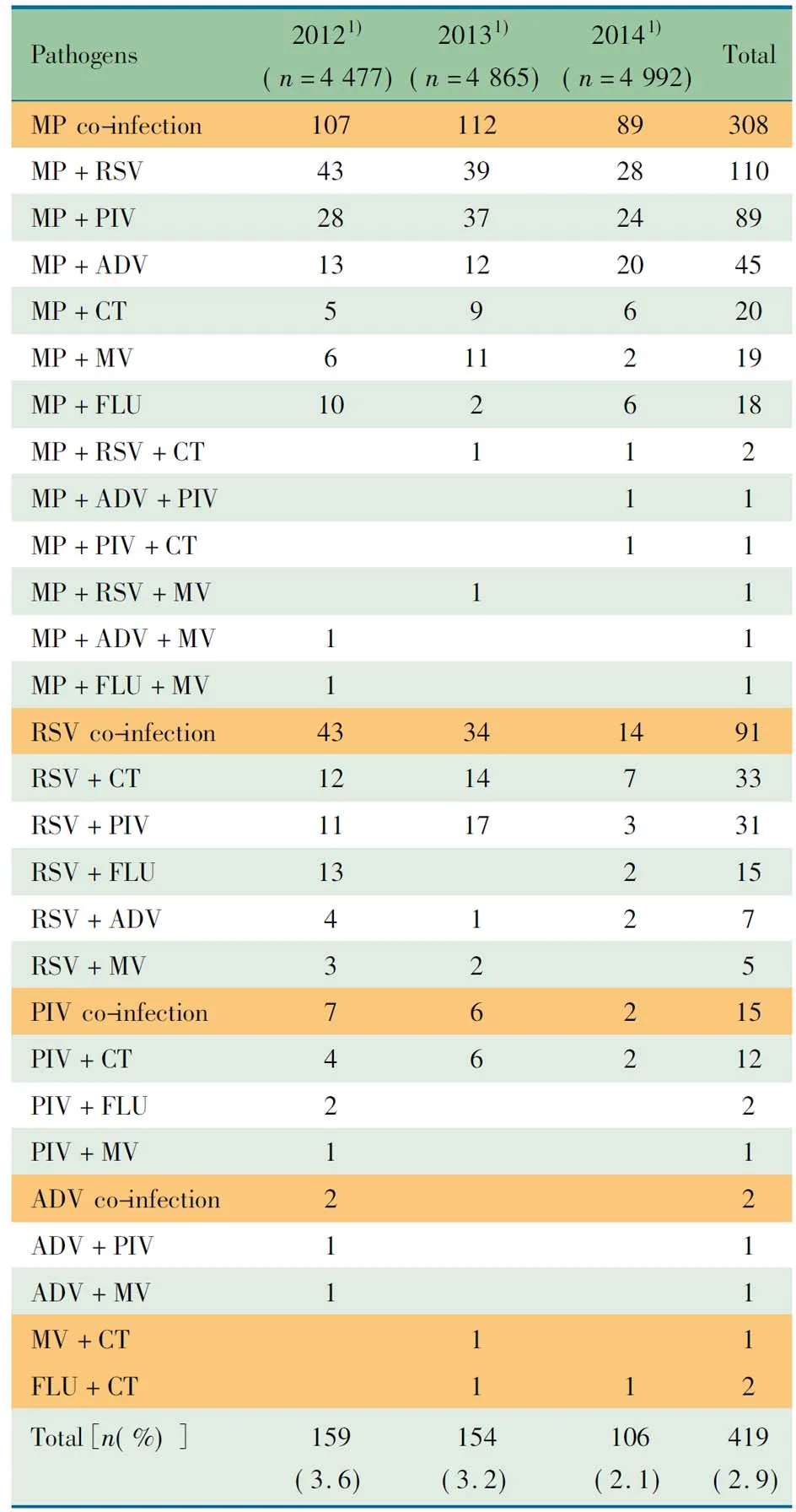2011至2014年上海单中心下呼吸道感染住院患儿常见病原体流行病学研究
2015-05-05柳鹏程苏犁云曹凌峰董左权徐梦华卢丽娟
柳鹏程 苏犁云 曹凌峰 董左权 徐梦华 卢丽娟 徐 锦
·论著·
2011至2014年上海单中心下呼吸道感染住院患儿常见病原体流行病学研究
柳鹏程 苏犁云 曹凌峰 董左权 徐梦华 卢丽娟 徐 锦
目的 分析近3年上海一家医院下呼吸道感染(LRTI)住院患儿中呼吸道合胞病毒(RSV)、腺病毒(ADV)、副流感病毒(PIV)、流感病毒(FLU)、人偏肺病毒(MV)、沙眼衣原体(CT)和肺炎支原体(MP)7种常见病原体的流行病学特征,为上海地区儿童LRTI的预防与诊治提供数据支持。方法 收集2011年10月至2014年9月于复旦大学附属儿科医院就诊的LRTI住院患儿,取其鼻咽部抽吸物,使用直接免疫荧光法或实时荧光定量PCR技术检测上述7种呼吸道病原体,并对其流行病学特征行描述性分析。结果 3年的呼吸道病原体总检出率为44.0%(6 301/14 334),MP的检出率最高(17.5%),其次为RSV(13.9%)和PIV(5.6%)。男、女呼吸道病原体的总检出率差异无统计学意义(χ2=0.68,P=0.408)。0~6月龄患儿以RSV检出率最高,>2岁患儿以MP检出率最高。RSV和CT随着年龄的增长检出率显著降低,MP的检出率随着年龄增长而显著升高。RSV的检出率高峰出现在冬季,夏季少见。ADV在春夏季检出率较高,而在秋季少见。PIV和MP检出率的高峰主要出现在夏季,FLU在1月份有暴发性的流行,MV的检出高峰主要出现在每年3月份;CT全年散发,无明显季节特征。病原体混合感染的总检出率为2.9%,在7~12月龄患儿中检出率最高,其中以MP合并其他病原体感染为主,最常见为MP+RSV的混合感染。结论 多种病原体导致上海地区儿童的LRTI,不同病原体显示出不同的流行季节、年龄分布等流行特征。
儿童; 呼吸道病原体; 下呼吸道感染; 流行病学
呼吸道感染是婴幼儿时期最常见的疾病,也是导致包括中国在内的发展中国家5岁以下儿童死亡的主要原因之一[1]。引起呼吸道感染的病原体种类繁多,其中以病毒最多见,常见的呼吸道病毒包括呼吸道合胞病毒(RSV)、腺病毒(ADV)、副流感病毒(PIV)、流感病毒(FLU)及近10年来新发现的偏肺病毒(MV)[2]。除此之外,非典型病原体如沙眼衣原体(CT)和肺炎支原体(MP)也是引起儿童呼吸道感染的重要病原体,且在混合感染中起到重要作用[3]。
呼吸道病原体的流行与季节、年龄、性别存在一定相关性,且不同地区存在一定的差异性,这种差异可能是由于气候、社会文化、经济和卫生条件等不同所致[4~7]。国内不同地区对当地儿童呼吸道病原的流行特征已有相关报道[8~10],上海地区近几年儿童呼吸道病原体流行特征的研究较少。本文收集复旦大学附属儿科医院(我院)近3年住院患儿的呼吸道标本,并对其病原学检测结果进行描述性分析,旨在了解上海地区呼吸道病原体在儿童中的最新流行趋势。
1 方法
1.1 纳入标准 ①2011年10月至2014年9月于我院治疗、临床诊断为下呼吸道感染(LRTI)并采集鼻咽部抽吸物(NPA)的患儿。
1.2 排除标准 ①同一病例多次采集NPA排除第1次NPA外的NPA标本;②未完整检测本文7个病原体NPA标本;③人口学信息不完整(性别、年龄、采集时间)。
1.3 分组及其定义 以每年9月作为年度划分,分为2012、2013和2014年度;依据检测时的年龄分为0~6月龄组、~12月龄组、~24月龄组、~5岁组和>5岁组;依据患儿检出病原体种类分为单一病原体感染和混合感染(≥2种病原体感染);春季为每年3~5月,夏季为~8月,秋季为~11月,冬季为12、1和2月。
1.4 病毒检测 负压吸取患儿NPA至2 mL生理盐水管中,用吸管反复吹打至黏液打碎,弃上清,用PBS清洗沉淀2次,点样于载玻片上,吹干后用冷丙酮4℃固定8~10 min,晾干。直接免疫荧光法(美国Diagnostic Hybrids)检测RSV、ADV、PIV、FLU和MV。荧光显微镜型号为Lecia DM2500型。
1.5 非典型病原体检测
1.5.1 DNA制备 向NPA中加入2~3倍的4%氢氧化钠溶液混匀,室温放置10 min,取液化后的标本1 mL于无菌离心管,12 000 r·min-1离心15 min,弃上清,沉淀用蒸馏水洗涤2次,弃上清。加50 μL DNA提取液于沉淀中,100℃恒温10 min,12 000 r·min-1离心5 min后留上清备用。
1.5.2 Real-time PCR检测 使用荧光定量检测试剂盒(中山大学达安基因股份有限公司)行CT和MP的检测,严格按照说明书进行操作。
1.6 统计学方法 采用SPSS 17.0软件行统计学分析,对不同性别、年龄、月份的病原体感染情况行比较分析,组间比较采用χ2检验,P<0.05为差异有统计学意义。
2 结果
2.1 一般情况 3年间共收集15 620份NPA,排除未完整检测7种病原体5例、人口学信息不完整12例、同一病例住院期间除第1次NPA以外NPA标本1 269例,进入本文分析的NPA样本14 334例。男9 067例(63.3%),女5 267例。2012年度4 477例,2013年度4 865例, 2014年度4 992例。0~6月龄组6 180例(43.1%),~12月龄组1 980例(13.8%),~24月龄组1 567例(10.9%),~5岁组3 008例(21.0%),>5岁组1 599例(11.2%)。13 646例(95.2%)NPA采集于入院后的48 h以内。
2.2 病原体的总检出情况 表1显示,3年病原体的总检出率44.0% (6 301/14 334),2014年度的检出率显著低于2012和2013年度(χ2=85.62,P=0.000)。14 334例病原体检出前3位分别为MP 17.5%(2 509)、RSV 13.9%(1 996)和PIV 5.6%(803)。RSV检出率2012年度显著高于2013和2014年度,MP检出率2013年度显著高于2012和2014年度。男女病原体总检出率差异无统计学意义(43.7%vs44.4%,χ2=0.68,P=0.408)。3年的混合感染率呈逐年下降趋势。
表1 3个年度呼吸道病原体的检出率[n(%)]
Tab 1 Detection rates of respiratory pathogens in three years[n(%)]

20121)(n=4477)20131)(n=4865)20141)(n=4992)Total(n=14334)RSV805(18.0)2)627(12.9)564(11.3)1996(13.9)ADV77(1.7)74(1.5)154(3.1)305(2.1)PIV237(5.3)323(6.6)243(4.9)803(5.6)FLU110(2.5)27(0.6)96(1.9)233(1.6)MV69(1.5)80(1.6)33(0.7)182(1.3)CT87(1.9)84(1.7)82(1.6)253(1.8)MP732(16.4)1035(21.3)2)762(15.3)2509(17.5)Total2117(47.3)2250(46.2)1934(38.7)2)6301(44.0)Co-infec-tion155(3.5)112(2.3)106(2.1)373(2.6)
Notes 1) From October last year to September this year. 2)vsother years,P<0.05
2.3 不同年龄组的病原检出情况 图1显示,病原体的总检出率随年龄增长而增高;0~6月龄组以RSV检出率最高,>2岁患儿以MP检出率最高;RSV和CT的检出率呈现出随着年龄增长而降低的趋势, 两者在0~6月龄组检出率均最高;MP的检出率随年龄增长有明显的上升,>5岁组检出率达51.2%;ADV和MV在~24月龄组、~5岁组、>5岁组检出率均较高;PIV在~12月龄组、~24月龄组的检出率最高,2个年龄组差异无统计学意义(χ2=1.99,P=0.159)。FLU在0~6月龄组的检出率显著低于其他年龄组,其他年龄组间检出率差异不显著 (χ2=6.41,P=0.093)。混合感染在~12月龄组检出率最高。

图1 不同年龄组各呼吸道病原体的检出率
Fig 1 Detection rates of respiratory pathogens in different age groups of patients
Notes m: months; y: years
2.4 病原体混合感染的检出情况 表2显示,3个年度共检出病原体混合感染419例,检出率为2.9% ,其中检出三重感染7例。MP混合感染占73.5%(308/419),其中以MP+RSV和MP+ PIV常见,除MP以外的RSV混合感染占21.7%(91/419),其中以RSV+CT和RSV+PIV为常见。
2.5 病原体感染的季节分布特点 图3A显示,RSV在3个年度的冬季检出最多,在夏季检出较少;图3B显示,ADV在3个年度春夏季检出率较高,秋季检出较少;图3C显示,PIV在3个年度夏季检出率高,均以7月份检出率最高; 图3D显示,FLU在2012年和2014的1月份检出率最高,而2013年未呈现高峰期;图3E显示,MV在3个年度的3月份检出率高;图3F显示,CT全年散发,与季节无明显相关性; 图3G显示,MP在夏秋季具有较高的检出率; 图3H显示,混合感染呈现冬季多发。
表2 3个年度混合感染类型的分布(n)
Tab 2 The distribution of co-infection types in different years(n)

Pathogens20121)(n=4477)20131)(n=4865)20141)(n=4992)TotalMPco-infection10711289308MP+RSV433928110MP+PIV28372489MP+ADV13122045MP+CT59620MP+MV611219MP+FLU102618MP+RSV+CT112MP+ADV+PIV11MP+PIV+CT11MP+RSV+MV11MP+ADV+MV11MP+FLU+MV11RSVco-infection43341491RSV+CT1214733RSV+PIV1117331RSV+FLU13215RSV+ADV4127RSV+MV325PIVco-infection76215PIV+CT46212PIV+FLU22PIV+MV11ADVco-infection22ADV+PIV11ADV+MV11MV+CT11FLU+CT112Total[n(%)]159(3.6)154(3.2)106(2.1)419(2.9)
Notes 1) From October last year to September this year
3 讨论
本研究一家医院7种常见病原体的总检出率为44.0%,与苏州地区(43.2%)相一致[11],高于重庆地区(38.2%)[12],低于广州地区(55.7%)[13]和美国多中心(孟菲斯、纳什维尔、盐湖城)研究的结果(81.1%)[14]。可能与病原体的流行和NPA纳入标准不同、检测方法学不同等因素相关。美国多中心研究和广州地区研究的纳入标准更加严格,其LRTI的诊断有影像学支持依据,同时其检测的呼吸道病原体的种类也更多,美国多中心研究还包含呼吸道感染细菌的检测。本文结果发现,3年来LRTI病例数呈逐年上升态势,而病原体检出率呈下降趋势,可能与EV68在上海地区2014年仍有一定流行有关,而EV68不在本文检测范围内。有文献报道2014年全球范围内爆发了可引起儿童肺炎的EV68流行[15,16]。

图2 2011年10月至2014年9月呼吸道病原体的季节分布
Fig 2 Seasonal distribution of respiratory pathogens from October 2011 to September 2014
Notes A: RSV; B: ADV; C: PIV; D: FLU; E: MV; F: CT; G: MP; H: Co-infection
病原体的总检出率和MP的检出率随年龄增长而增高,2岁之后呈快速上升的趋势(总检出率从38.3%上升至59.2%,MP检出率从14.0%上升至51.2%)。其原因是MP主要以气溶胶的方式通过呼吸系统传播,在人口密集处多发,学校中人口密度较大,空气流通性差,有利于MP的传播,故学龄前和学龄期的儿童MP感染风险会显著增加。CT是常见的性传播病原体,受感染的孕妇经产道分娩时可将CT传染给新生儿而引起CT肺炎,故CT检出主要在6月龄以下。深圳地区研究显示[17],6月龄以下肺炎患儿中CT的检出率为7.2%,而本文仅为3.7%,除地域差异外,标本纳入标准不同(其LRTI由X线胸片作为辅助诊断)可能是造成差异的主要原因。RSV的检出率随着年龄的增长而下降(从21.3%下降至2.0%),可能与接触传播是RSV的主要传播途径之一,来自母体的抗体对RSV感染无保护作用有关,故6月龄以下儿童最易感染,随着年龄的增长免疫系统逐渐成熟,RSV感染率逐渐下降。
多重感染在LRTI患儿中较为常见,特别是当患儿有潜在疾病时[18]。MP感染占混合感染的73.5%(308/419),以MP+RSV最为常见,占混合感染的26.3%(110/419),与这些病原体在本研究中的高检出率相一致。重庆地区研究显示,其混合感染中MP+FLU多见,占51.6%[11],广州地区以RSV+FLU居于首位[15],亦同样表现为与这些病原体高检出率相一致。表明不同病原体的检出率情况可能决定了不同混合感染类型流行情况,即高检出率的病原体同时也会是混合感染中的主要病原体。
RSV、FLU、MV呈大致相同的季节性流行,在较为寒冷的月份具有较高的检出率,与美国多中心在2010年1月至2012年6月的研究[14],和中国6个省市在2009年1月至2012年12月研究的结果相符合[19]。但中国香港地区在2005年11月至2006年10月和越南地区在2007年12月至2008年12月的研究显示,RSV在冬季少发,而在2月份到9月份均较为常见[5,8]。可能是因为潮湿和寒冷是RSV的高发因素,在温带地区其好发于寒冷的冬季,在热带亚热带地区其好发于雨水充沛的季节[20,21]。ADV、PIV和MP呈大致相同的季节性流行,主要发生于温度较高的春夏季节,与广州地区的相关研究相一致[13],而美国多中心研究显示MP在冬季达到检出的高峰[14]。韩国相关研究观察1986至2004年儿童MP感染的流行特征,发现其流行高峰出现在秋季或冬季[22]。表明MP在不同国家间流行特征存在着多样性,气候差异可能是其主要原因。
本研究尚存在以下不足之处:①标本来源于单中心的3年连续LRTI住院患儿鼻咽部抽吸物,并不能完全反映上海地区儿童的呼吸道病原体流行情况。②虽然大部分样本(95.2%)是以社区获得性感染诊断要求在入院48 h以内采集的,仍然有部分标本为入院48 h后采集。③只纳入了7种常见的呼吸道病原体,在这些病原体之外尚有许多常见病原体未纳入检测范围,不能完整展现LRTI病原谱。
[1]Rudan I, Guo Y, Campbell H, et al. Causes of deaths in children younger than 5 years in China in 2008. The Lancet, 2010, 375(9720):1083-1089
[2]Feuillet F, Lina B, Rosa-Calatrava M, et al. Ten years of human metapneumovirus research. J Clin Virol, 2012, 53(2):97-105
[3]Pientong C, Ekalaksananan T, Teeratakulpisarn J, et al. Atypical bacterial pathogen infection in children with acute bronchiolitis in northeast Thailand. J Microbiol Immunol, 2011, 44(2):95-100
[4]Feng L, Li Z, Zhao S, et al. Viral etiologies of hospitalized acute lower respiratory infection patients in China, 2009-2013. PLoS One, 2014, 9(6):e99419
[5]Khamis FA, Al-Kobaisi MF, Al-Areimi WS, et al. Epidemiology of respiratory virus infections among infants and young children admitted to hospital in Oman. J Med Virol, 2012, 84(8):1323-1329
[6]Turner P, Turner C, Watthanaworawit W, et al. Respiratory virus surveillance in hospitalized pneumonia patients on the Thailand-Myanmar border. BMC Infect Dis, 2013, 13:434
[7]Fairchok MP, Martin ET, Chambers S, et al. Epidemiology of viral respiratory tract infections in a prospective cohort of infants and toddlers attending daycare. J Clin Virol, 2010, 49(1):16-20
[8]Sung RY, Chan PK, Tsen T, et al. Identification of viral and atypical bacterial pathogens in children hospitalized with acute respiratory infections in Hong Kong by multiplex PCR assays. J Med Virol, 2009, 81(1):153-159
[9]Lu Y, Wang S, Zhang L, et al. Epidemiology of Human Respiratory Viruses in Children with Acute Respiratory Tract Infections in Jinan, China. Clin Dev Immunol, 2013, 2013:1-8
[10]He Y, Lin G, Wang Q, et al. A 3-year prospective study of the epidemiology of acute respiratory viral infections in hospitalized children in Shenzhen, China. Influenza Other Respir Virus, 2014, 8(4):443-451
[11]Xue B(薛白), Liu J, Hu ZG, et al. Etiological analysis of respiratory tract infections. Clin J Nosocomiol(中华医院感染学杂志), 2014,24(2):309-311
[12]Liao B(廖兵), Zhang SQ, Xu YY. Epidemiological investigation on pathogens causing respiratory infection of children. Lab Med Clin (检验医学与临床), 2014(14):1918-1920
[13]Liu WK, Liu Q, Chen DH, et al. Epidemiology of acute respiratory infections in children in Guangzhou: a three-year study. Plos One, 2014, 9(5):e96674
[12]Li XJ(李晓娟), Liu YN, Wang SY. Etiologic features of 846 hospitalized children with acute respiratory tract infection. China Tropical Medicine(中国热带医学), 2014(06):703-706
[13]Wu Q(吴茜), Wen BP, Li YF, et al. Clinical and etiological analysis of 1402 children with acute lower respiratory tract infections. Chin J Obstet Gynecol Pediatr(中华妇幼临床医学杂志), 2012(03):312-316
[14]Jain S, Williams DJ, Arnold SR, et al. Community-acquired pneumonia requiring hospitalization among U.S. children. N Engl J Med, 2015, 372(9):835-845
[15]Du J, Zheng B, Zheng W, et al. Analysis of Enterovirus 68 Strains from the 2014 North American Outbreak Reveals a New Clade, Indicating Viral Evolution. Plos One, 2015, 10(12):e144208
[16]Schuster JE, Newland JG. Management of the 2014 Enterovirus 68 Outbreak at a Pediatric Tertiary Care Center. Clin Ther, 2015, 37(11):2411-2418
[17]Li Y, Xiong L, Huang Y, et al. The clinical characteristics and genotype distribution of Chlamydia trachomatis infection in infants less than six months of age hospitalized with pneumonia. Infect Genet Evol, 2015, 29:48-52
[18]Richard N, Komurian-Pradel F, Javouhey E, et al. The impact of dual viral infection in infants admitted to a pediatric intensive care unit associated with severe bronchiolitis. Pediatr Infect Dis J, 2008, 27(3):213-217
[19]Feng LZ(冯录召), Lai SJ, Li F, et al. Viral etiologies of hospitalized pneumonia patients aged less than five years in six provinces,2009-2012. Chin J Epidemiol(中华流行病学杂志), 2014(6):646-649
[20]Do AH, van Doorn HR, Nghiem MN, et al. Viral etiologies of acute respiratory infections among hospitalized Vietnamese children in Ho Chi Minh City, 2004-2008. Plos One, 2011, 6(3):e18176
[21]Panayiotou C, Richter J, Koliou M, et al. Epidemiology of respiratory syncytial virus in children in Cyprus during three consecutive winter seasons (2010-2013): age distribution, seasonality and association between prevalent genotypes and disease severity. Epidemiol Infect, 2014, 142(11):2406-2411
[22]Eun BW, Kim NH, Choi EH, et al. Mycoplasma pneumoniae in Korean children: The epidemiology of pneumonia over an 18-year period. J Infect, 2008, 56 (5):326-331
(本文编辑:张崇凡)
Epidemiological study of pathogens leading to lower respiratory infection among hospitalized children in Shanghai, 2011-2014
LIUPeng-cheng,SULi-yun,CAOLing-feng,DONGZuo-quan,XUMeng-hua,LULi-juan,XUJin
(DepartmentofClinicalLaboratory,Children′sHospitalofFudanUniversity;Shanghai201102,China)
XU Jin,E-mail:jin030101@aliyun.com
ObjectiveAn epidemiological study on respiratory syncytial virus (RSV), adenovirus (ADV), parainfluenza virus (PIV), influenza virus (FLU), human metapneumovirus (MV), chlamydia trachomatis (CT) and mycoplasma pneumoniae (MP) was conducted in hospitalized children with lower respiratory infection (LRTI) in Shanghai. The objective of this study was to provide the basic data support for prevention, diagnosis and treatment of LRTI in children. MethodsA total of 14 334 hospitalized children with LRTI from Children′s Hospital of Fudan University during October 2011 and September 2014 were enrolled, and nasopharyngeal aspirates (NPA) were collected and tested by direct immunofluorescence assay (DFA) or real time PCR, and then the epidemiological characteristics of different respiratory pathogens were analyzed.ResultsThe total detection rate of respiratory pathogens was 44.0% (6301/14 334). The most frequent detected pathogen was MP which accounted for 17.5% (2 509/14 334), followed by RSV (1 996/14 334, 13.9%) and PIV (803/14 334, 5.6%). The detection rate did not significantly differ between genders (χ2=0.68,P=0.408). The detection rates of pathogens had significant correlation with age and season. RSV was the most prevalent pathogen in the youngest children below or at 6 months old, while the most frequent detected pathogen in children over 2 years old was MP. The detection rates of RSV and CT significantly declined with age, meanwhile the detection rate of MP increased with age. RSV infection peaked in winter, but was rarely detected in summer. The detection of ADV increased in spring and summer, but was rarely detected in autum. PIV and MP infections peaked in summer. FLU caused an explosive epidemic in January of 2012 and 2014. The peak of MV occurred around March. CT activity was observed throughout the year without significant seasonality. Co-infection rate was 2.6% (373/14 334) and the highest rate of co-infection was found in children aged -12 months. The combination of MP plus another pathogen was the most common co-infection and MP+RSV was the predominant co-infection type.ConclusionA variety of pathogens lead to children′s lower respiratory tract infections in Shanghai. Different pathogens demonstrated different epidemiological pattern concerning seasons and ages distribution.
Children; Respiratory pathogens; Lower respiratory tract infection; Epidemiology
上海市申康医院发展中心临床辅助科室能力建设项目:SHDC22014015;国家自然科学基金面上项目:NSFC81273204
复旦大学附属儿科医院临床检验中心 上海,201102
徐锦,E-mail:jin030101@aliyun.com
10.3969/j.issn.1673-5501.2015.06.010
2015-09-30
2015-11-27)
